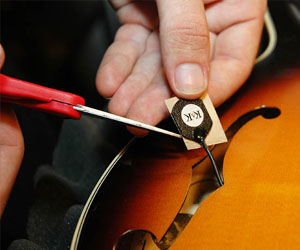Guitar Tuning Pegs Repair
A guitar has many replaceable parts for the convenience of the player. If a string breaks, another is right at hand to replace it. If the pickups stop working, replacements can be ordered and installed. Among the smaller issues to deal with when maintaining guitars, guitar tuning pegs, or machineheads, can sometimes be the cause of losing tone while playing and not hitting the right pitch to begin with while tuning. If you suspect that your guitar tuning pegs may be broken, repair is the best solution if it is possible.
Should You Repair Yourself or Take it In?
Machineheads are not difficult machinery to figure out. They basically consist of two cogs that rotate as a result of the manual work of turning the tuning knob. They're usually fixed onto the guitar headstock by screws. There are some configurations of heads that would be better left to a professional. If you're learning how to repair, use an old guitar. If you need your primary guitar fixed, don't hesitate to take it into the shop. The following places readily accept instruments for repairs:
- Sam Ash
- George's Music
- Any independent NAPBIRT Certified Repair shop
- Yamaha
Don't risk ruining your primary instrument by working on it yourself blindly. Let professionals handle repairs. If you are eager to learn the trade, practice with older instruments. This will protect your investments.
Replacing Machineheads
Replacing machineheads is a matter of having the right equipment. Some guitars feature screws that can only be unscrewed using a special shaped allen wrench tool. Trying to unscrew these with any other kind of tool is counter-productive as it will strip the screw head. Always use the proper tools if you're working on a guitar – if you don't have them, get them or get a professional. If your guitar is made with machineheads that feature normal screw heads, simply unscrew the machinehead from the headstock and screw in the new tuning pegs. When choosing to update your machineheads, be sure that the dimensions will fit well on your headstock. Cramped strings can make for bad tone. Guitar tuning pegs repair isn't ever difficult but sometimes it does require specialized tools. Be aware of what guitar you may be working on and prepare for disaster by investing in tools to take the guitar apart, piece by piece.
Repairing Tuning Peg Parts Versus Full Replacement
Advantages to repairing versus replacing have long been noted: hardy machines can be built requiring regular maintenance, which increases the profitability of the device and introduces a whole new market – the repair industry. Repairing allows for the same unit to function longer given new parts that may have degraded. Warranties may order for full replacement of the guitar if there is a factory defect. This is often a wise move. Unless you know that a factory defect will be worth money in time, don't keep it. Tuning pegs are good to update, replace and repair – if the set you've got is salvageable, try saving it through repair.

